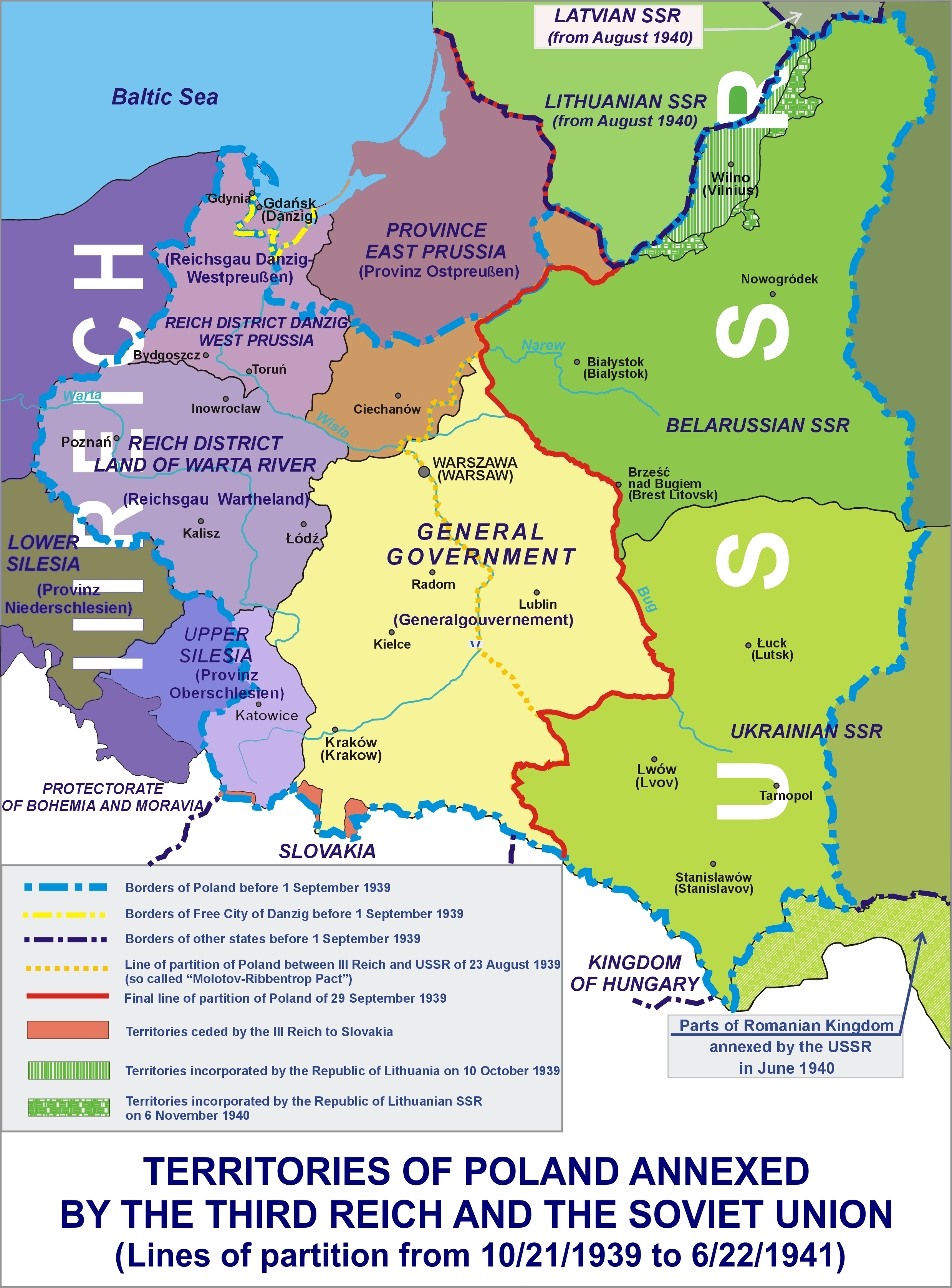
Polish areas annexed by Nazi Germany
Following the Invasion of Poland at the beginning of World War II, nearly a quarter of the entire territory of the Second Polish Republic was annexed by Nazi Germany and placed directly under the German civil administration. The rest of Nazi-occupied Poland was renamed as the General Government district.[1] The annexation was part of the "fourth partition of Poland" by Nazi Germany and the Soviet Union, outlined months before the invasion, in the Molotov–Ribbentrop Pact.[2]
This article is about the Polish territories annexed into Nazi Germany. For the other territories that were occupied in 1939 but not directly annexed, see General Government.
Some smaller territories were incorporated directly into the existing Gaue East Prussia and Silesia, while the bulk of the land was used to create new Reichsgaue Danzig-West Prussia and Wartheland. Of those, Reichsgau Wartheland was the largest and the only one comprising solely the annexed territory.[3]
The official term used by the Nazi authorities for these areas was the "incorporated Eastern territories" (German: Eingegliederte Ostgebiete).[4] They planned for a complete Germanization of the annexed territories, considering them part of their lebensraum.[5] The local Jewish population was forced to live in ghettos, and was gradually deported to concentration and extermination camps, the most infamous of which, Auschwitz, was located in annexed East Upper Silesia. The local Polish population was to be gradually enslaved, exterminated and eventually replaced by German settlers. The Polish elite especially became subject to mass murder,[6] and an estimated 780,000 Poles were subject to expulsion, either to the General Government or to the Altreich for forced labour. The remaining Polish population was strictly segregated from the German population and subject to a variety of repressive measures. These included forced labour and their exclusion from all political and many cultural aspects of society. At the same time, the local German minority was granted several privileges, and their number was steadily raised by the settlement of ethnic Germans, including those displaced by the Nazi-Soviet population transfers.[7]
After the Vistula–Oder Offensive in early 1945, the Soviet Union took control over the territories. The ethnic German population either fled the Red Army or were later expelled and the territories became part of the People's Republic of Poland.
Background
Already in the fall of 1933 Adolf Hitler revealed to his closest associates his intentions to annex western Poland into an envisioned Greater Germany.[8] In October 1939, a month after the invasion of Poland, Nazi Germany annexed an area of 92,500 square kilometres (35,700 sq mi)[2] (23.7%[2] of pre-war Poland) with a population of about 10,000,000 people (30%[2] of the pre-war Polish population).[9][10] The remainder of the Polish territory was either annexed by the Soviet Union (201,000 km2[2] or 51.6%[2] of pre-war Poland as per the Molotov–Ribbentrop Pact) or made into the German-controlled General Government occupation zone (95,500 km2[2] or 24.5%[2] of pre-war Poland). A tiny portion of pre-war Poland (700 km2[2]) was annexed by Slovakia.
Since 1935, Nazi Germany was divided into provinces (Gaue) which had replaced the former German states and Prussian provinces. Of the territories annexed, some were attached to the already existing Gaue East Prussia and Silesia (later Upper Silesia), while from others new Reichsgaue Danzig-West Prussia and Wartheland were constituted. Wartheland was the only Gau constituted solely from annexed territory,[3] Danzig-West Prussia comprised also former German areas and the former Free City of Danzig. The occupied General Government remained outside Nazi Germany.
The annexation violated international law (in particular, the Hague Convention IV 1907).[11][12] Nazi Germany's officials discussed the convention and tried to circumvent it by declaring the war against Poland over prior to the annexation, which in their view made the convention non-applicable.[12]
Post-war changes
None of the Nazi-ordered territorial changes were recognised by the Allies of World War II, and the annexed territories became the centre of the People's Republic of Poland after World War II. Germans living in the formerly annexed territories fled or were expelled to post-war Germany. In post-war Poland, some captured German Nazis and collaborators were put on trial. West Germany did not extradite people charged in Poland.